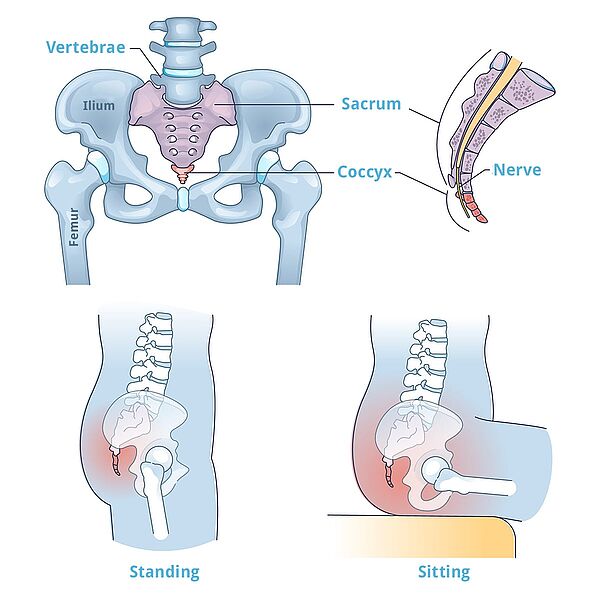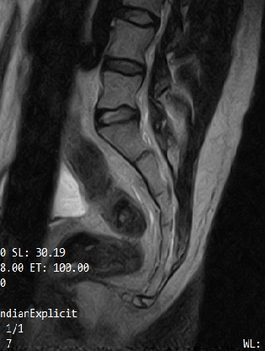What is the coccyx? Where is it located on the spine?
Coccyx pain, also called coccygodynia, is often a result of falling on the buttocks. So most people really don't become aware of the coccyx until they have fallen on it once and suffer pain in the tailbone. It doesn't matter if it's on wet fall leaves, icy sidewalks or slippery stair landings. Sports accidents also cause coccygodynia all the time.
The coccyx is the tail end of the spine. The two to five bone segments that make up the tailbone are usually firmly attached to each other, forming a triangular bone. As the lowest point of the spine, the coccyx serves as the attachment point for the muscles, tendons and ligaments of the pelvis. The coccyx is one of several switching points of the complete body statics. It may be small, but it can have a big impact on our well-being.
Like the tibia, the coccyx is surrounded only by a thin, delicate periosteum that offers little protection. Developmentally, the tailbone is the regressed part of the caudal skeleton that is close to the body. When walking or standing, the coccyx does not move. When sitting, x-rays have shown that the coccyx can have forward and backward mobility of up to 20 degrees. Injuries to the coccyx are not only painful, but also long lasting. For years after a fall, you remember where you were when the pain went through your whole body - stabbing, pulling, painful.
Typical symptom - a sharp, burning pain in the coccyx area.
Not all diseases and illnesses have typical symptoms that provide decisive clues to the problem. With pain in the coccyx, this is different. The typical symptom is a stabbing, burning pain in the tailbone area. It is also possible for the pain to spread to other regions such as the hip, lumbar and anal areas. The biggest problem: Patients suffering from coccygodynia usually cannot sit on hard surfaces for long periods of time, and do so poorly. The pain may occur right away when sitting, only after sitting for a longer period of time, or even when standing up. Climbing stairs and having a bowel movement, even sexual intercourse are often painful. Such complaints also often occur after inflammation of the periosteum. Coccystitis, for which there are usually two causes, develops in the vascular fold running between the coccyx and the anus. The trigger for this condition is either inflammation of the periosteum or inflammation of the tissue at the coccyx.
In addition, attack-like nerve pain may occur. They are triggered by the fact that the nerve plexus in the tissue at the lower sacrum and coccyx is affected. But no matter what the reason, sufferers are usually unable to sit for days, weeks, sometimes even months without suffering. Beware of coccyx pain! If you don't seek help from a specialist, you can expect coccygodynia to become chronic.
In coccyx pain, women are more often affected than men
Unfortunately, women suffer from coccyx pain more often than men. The reason: the coccyx is heavily stressed by pregnancy and especially by childbirth. Why? One of the answers: the coccyx is located directly behind the uterus. As the baby grows, it can press on the tailbone, causing discomfort.
However, the most common reason for pain in the tailbone is sitting too long. In fact, an office worker spends 80,000 hours in the buttocks over the course of his or her working life. The sedentary nature of what should be a sedentary person often adds up to 10 to 14 hours a day in Western countries. 14 million pupils and students are predominantly taught while sitting. The average German sits 9.6 hours a day. This not only causes the postural muscles to curl and leads to back pain, but also promotes vascular diseases such as coccygeal fistula. A coccyx contusion occurs far more frequently than a fracture of the tailbone.
Causes of pain in the coccyx
Dr. Munther Sabarini: "Coccygodynia is often not taken seriously as a disease. Even when those affected complain of pain - usually traumatically triggered complex complaints - and impairments in everyday life. The patients who come to our international spine clinic in Berlin often have a years-long odyssey behind them. They run from doctor to doctor without getting any real help or an accurate diagnosis. That's because finding the cause is actually not as easy as patients - and doctors - would like."
In fact, coccyx pain is predominantly the result of falls on the buttocks - for example, from falling in sports accidents. From bruises to a coccyx fracture, a lot can happen in this region. However, a certain fatigue or permanent one-sided load can also cause the end of the spine to break. If the bone substance in this area has suffered (for example, in osteoporosis), coccyx fractures can also occur.
The most common causes of coccyx pain (coccygodynia)
- Bruises or fractures cause severe pain, which is felt especially when sitting, climbing stairs, having a bowel movement and even during sexual intercourse. Or complicated deliveries, irritations in the area of the muscle attachments or tendons on the bone (tendopathies), tumors in the area of the coccyx or congenital coccyx anomalies are also known causes.
- Even prolonged sitting on softer surfaces (such as a sofa) can cause coccyx pain for some people. Therefore, in English coccygodynia has the nickname 'television bottom' or 'television butt'.
- Tumors, so-called chordomas, which can occur throughout the spine, are rightly feared. They destroy the bones; people over 60 years of age are predominantly affected by a tumor in this area. In absolutely exceptional cases, even children get a chordoma.
- Other possible causes of coccygodynia can be: periosteum inflammation, coccyx dislocation, coccyx fistula, malposition of the coccyx, injuries in the pelvic area, lumbalgia (e.g. lumbago), herniated disc, surgical interventions, nerve irritation, gynecological problems (e.g. endometriosis).
Diagnosis coccyx pain
Before the doctor can begin with the therapy, a detailed diagnosis is necessary. This includes the medical history interview, in which the doctor determines the biographical key points. The patient describes in detail the course of his pain and illness. Then the physical examination begins: if the pressure on the coccyx is painful, it is almost certainly coccygodynia. A clinical examination and imaging procedures of the entire spine round out the diagnostic process. It's important to know: Imaging procedures (e.g., X-ray of the coccyx, computed tomography, magnetic resonance imaging) usually do not reveal any visible changes. However, they should still be done to rule out local inflammation or a tumor on the coccyx. Magnetic resonance imaging (MRI) is much more informative, as it is easier to assess bony injuries, fractures and injuries to the adjacent soft tissues.
Tumors can also be easily detected on MRI. If there is actually a suspicion of inflammation or a tumor, the doctor orders contrast agents during the imaging examination to show the affected area of the body in even greater detail. Next - the examination from the inside: Using the rectum, the doctor can feel how mobile the coccyx is, detect tension in the pelvis or changes in the internal organs. If this examination - palpation of the coccyx - triggers pain for the patient, the suspicion of coccyx pain is confirmed.
Therapies include physical therapy and pain medication
Acute coccygodynia can be relieved by accompanying general therapy approaches.Conservative therapies such as medication pain therapy and local injections already relieve pain. Chronic coccygodynia pain, however, is feared for its long-term nature. If no cause can be found, local infiltrations with corticosteroids or local anesthetics can be inserted at the junction of the sacrum and coccyx. Analgesics as tablets may be administered to assist in treatment. Additional measures may include physical therapy/physiotherapy, certain exercises, and provision of a seating ring.
Possible treatments for coccyx pain that we offer at the spine clinic include conservative therapies, but also infiltrations and denervation. In denervation, the physician inserts a special needle under image intensifier control at the exact location of the irritated nerves (branches of the spinal nerve). The small nerve is irritated (stimulated) with the needle to see if the right spot is hit (neurostimulation). Then a laser, which comes through the needle via fiber optics, is directed to the affected area. The heat from the laser energy then shuts down the irritated nerve fibers (denervation).
Surgical removal of the coccyx (coccyx surgery) is considered for prolonged coccyx pain, but is rarely necessary.
Prognosis and prevention - you need to learn a back-friendly behavior
Are you familiar with the phrase "As long as people demand sitting rather than movement, it will remain difficult to relieve them of the negative consequences of sitting"? This means: After treatment or surgery on the coccyx, you as a patient must adopt a long-term back-friendly behavior in everyday life and leisure, especially in the way you sit, and strengthen your muscles. In plain language: more movement during the day, for example riding your bike to work, walking as many short distances as possible in the office (to the printer, for example...), taking a walk during your lunch break. The primary goal is always to protect the coccyx.
Prevention of coccyx pain
Here are three tips: Perfect for prevention (prevention in terms of a disease) of coccyx pain would be to replace your office chair with an ergonomic office chair or an ergonomic stool. A coccyx cushion, which allows the coccyx to lie almost pressure-free, is helpful. You will be more than surprised at the relief. And: get out of the vicious circle of sitting - this is certainly possible at your workplace. Live by the 40-15-5 rule. That means: sit for 40 minutes, work while standing for 15 minutes, walk around for 5 minutes. Incorporate gymnastic exercises into your daily routine - this will help you strengthen your back muscles and pelvic floor - and at the same time provide good relief for your tailbone.
Where can coccyx pain come from?
Coccygodynia (pain in the coccyx) often results from falls on the buttocks, for example during sports or during everyday life. The second, although rare, cause of coccyx pain is one-sided stress and resulting fatigue of the tailbone.
What are the symptoms of coccyx pain?
Symptoms of coccyx pain manifest themselves particularly when sitting, standing up or climbing stairs. Even on soft, comfortable surfaces, patients with coccygodynia often cannot sit without significant pain. Even during bowel movements or sexual intercourse, pain in the coccyx can lead to severe restrictions.
Information about the article
The article was last checked and updated on October, 20th, 2022.
About the author
Dr. med. Munther Sabarini, MD, is the director and founder of the Avicenna Clinic. As a specialist neurosurgeon, he particularly has expertise in the treatment of spinal disorders. Dr. Munther Sabarini has more than 30 years of professional experience. During this time he treated more than 30,000 patients.
Avicenna Clinic Content Quality Guidelines
All texts and content are written by medically trained, experienced experts in the field. Learn more about our content quality guidelines.
Sources and further literature
H. Mlitz, W. Jost: Leitlinien der Deutschen Gesellschaft für Koloproktologie – Kokzygodynie. AWMF-Leitlinien-Register, Nr. 81/005, 2002.
L.S. Lirett et al.: Coccydynia: An Overview of the Anatomy, Etiology, and Treatment of Coccyx Pain. The Ochsner Journal, Nr. 14, S. 84-87, 2014.
P. Pennekamp, C. Kraft, T. /Wallny: Die Steißbeinresektion in der Behandlung der Kokzygodynie. Zeitschrift für Orthopädie und Unfallchirurgie 141, S. 578–582, 2003.
Karla Schildt-Rudloff & Gabriele Harke. Wirbelsäule: Manuelle Untersuchung und Mobilisationsbehandlung für Ärzte und Physiotherapeuten. Urban & Fischer Verlag. 7. Auflage, München 2021.
The Avicenna Clinic in Berlin is always willing to help you
Since the year 2001, the Avicenna Clinic is based in Berlin. Our doctors have at least 25 years of international experience in their respective fields (neurosurgery, spinal surgery, anesthesia, and orthopedics).
If you have severe back pain, a herniated disc or a suspected herniation, please contact us using the following information:




